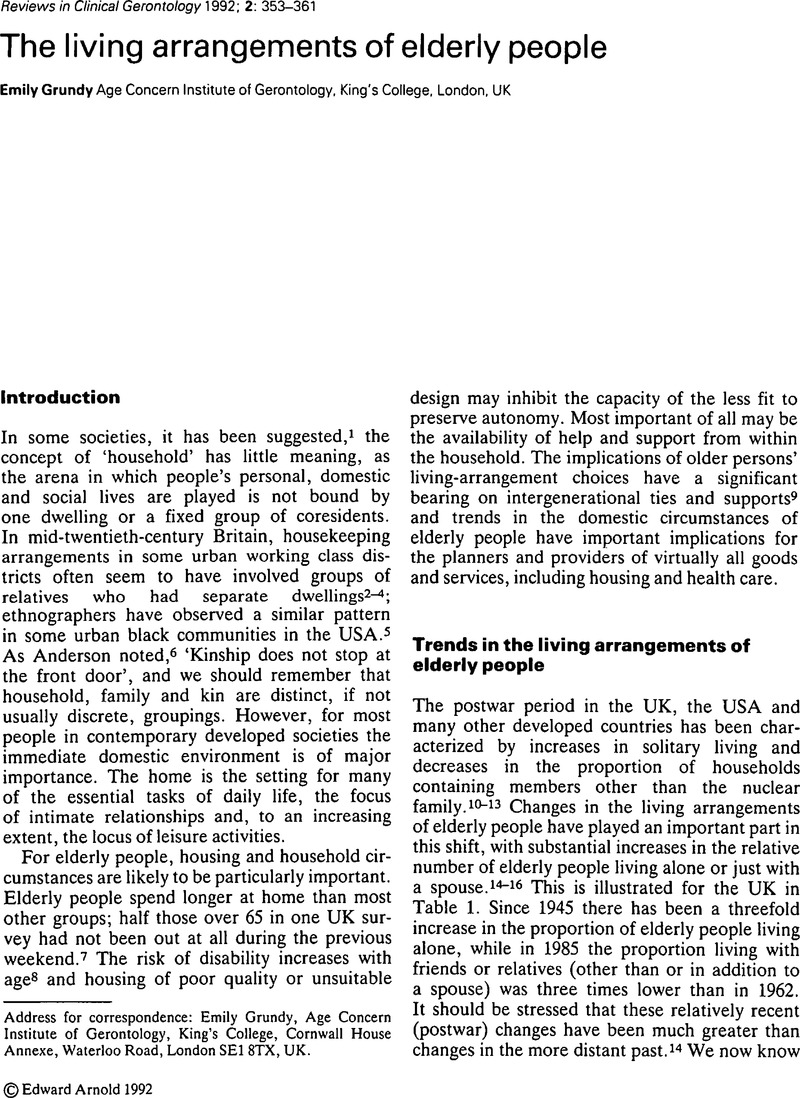Crossref Citations
This article has been cited by the following publications. This list is generated based on data provided by Crossref.
Arber, Sara
and
Ginn, Jay
1994.
Women and aging.
Reviews in Clinical Gerontology,
Vol. 4,
Issue. 4,
p.
349.
Jefferys, Margot
1996.
Cultural aspects of ageing: Gender and inter-generational issues.
Social Science & Medicine,
Vol. 43,
Issue. 5,
p.
681.
Phillipson, Chris
2002.
La prise en charge des parents âgés en Grande-Bretagne : perspectives sociologiques.
Lien social et Politiques,
p.
165.
Grundy, Emily
2007.
Ageing Well.
Vol. 20070544,
Issue. ,
p.
85.
Sibai, Abla M.
Yount, Kathryn M.
and
Fletcher, Astrid
2007.
Marital status, intergenerational co-residence and cardiovascular and all-cause mortality among middle-aged and older men and women during wartime in Beirut: Gains and liabilities.
Social Science & Medicine,
Vol. 64,
Issue. 1,
p.
64.
Grundy, Emily
2007.
Ages, Generations and the Social Contract.
p.
209.
Panapasa, Sela
Phua, Voon
and
McNally, James
2008.
Economic Hardship among Elderly Pacific Islanders.
AAPI Nexus Journal: Policy, Practice, and Community,
Vol. 6,
Issue. 2,
p.
67.
HENZ, URSULA
2009.
Couples' provision of informal care for parents and parents-in-law: far from sharing equally?.
Ageing and Society,
Vol. 29,
Issue. 3,
p.
369.
Taylor, Brian
and
Neill, Andrea
2009.
Sheltered housing and care for older people.
Quality in Ageing and Older Adults,
Vol. 10,
Issue. 4,
p.
18.
Mehio-Sibai, Abla
Beydoun, May A.
and
Tohme, Rania A.
2009.
Living Arrangements of Ever-Married Older Lebanese Women: Is Living with Married Children Advantageous?.
Journal of Cross-Cultural Gerontology,
Vol. 24,
Issue. 1,
p.
5.
Grundy, Emily
2010.
Aging in Advanced Industrial States.
p.
197.
Do, Y. K.
and
Malhotra, C.
2012.
The Effect of Coresidence With an Adult Child on Depressive Symptoms Among Older Widowed Women in South Korea: An Instrumental Variables Estimation.
The Journals of Gerontology Series B: Psychological Sciences and Social Sciences,
Vol. 67B,
Issue. 3,
p.
384.
Guo, Lihua
Zhang, Jie
Ma, Wei
Sha, Xiaojuan
Yi, Xiangren
Zhang, Bingyin
Wang, Chunping
and
Wang, Shumei
2015.
Offspring caregivers’ depression affected by intergenerational disagreements on preferred living arrangement for the elderly: A phenomena with Chinese characteristic.
Archives of Gerontology and Geriatrics,
Vol. 61,
Issue. 3,
p.
363.
Szołtysek, Mikołaj
Ogórek, Bartosz
Poniat, Radosław
and
Gruber, Siegfried
2019.
“One size does not fit all”: Spatial nonstationarity in the determinants of elderly residential isolation in historical Europe.
Population, Space and Place,
Vol. 25,
Issue. 6,
Hu, Yaoyue
Ruiz, Milagros
Bobak, Martin
and
Martikainen, Pekka
2020.
Do multigenerational living arrangements influence depressive symptoms in mid-late life? Cross-national findings from China and England.
Journal of Affective Disorders,
Vol. 277,
Issue. ,
p.
584.
Szołtysek, Mikołaj
Ogórek, Bartosz
Poniat, Radosław
and
Gruber, Siegfried
2020.
Making a Place for Space: A Demographic Spatial Perspective on Living Arrangements Among the Elderly in Historical Europe.
European Journal of Population,
Vol. 36,
Issue. 1,
p.
85.
Sandoval, Moisés H.
and
Alvear Portaccio, Marcela E.
2022.
Marital Status, Living Arrangements and Mortality at Older Ages in Chile, 2004–2016.
International Journal of Environmental Research and Public Health,
Vol. 19,
Issue. 21,
p.
13733.





